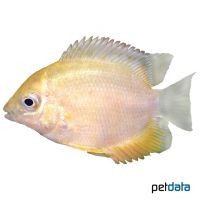Banded Cichlid Gold (Heros severus 'Gold')
| Banded Cichlid Gold Heros severus 'Gold' | |
|---|---|
| Name | Banded Cichlid Gold |
| Name Lat. | Heros severus 'Gold' |
| Synonym | Cichlasoma severum |
| Family | Cichlids |
| Family lat. | Cichlidae |
| Order | Cichlids |
| Order lat. | Cichliformes |
| Origin | South America |
| Habitat | Tributaries, ponds |
| Diet | Omnivore |
| pH | 5.0-7.0 |
| Behavior | Semi-aggressive |
| Keeping | Pair |
| Care Level | Moderate |
| Reproduction | Mouthbrooder |
| Breeding | Moderately difficult |
| Life Span | 5-8 years |
| Protection | No |
| Metric Units | |
| Size | 20-25 cm |
| Temperature | 24-30 °C |
| Hardness | 1-10 °dH |
| Aquarium | 300 l |
| US Units | |
| Size | 7.9"-9.8" |
| Temperature | 75-86 °F |
| Hardness | 18-178 ppm |
| Aquarium | 80 gal |
Distribution and habitat
The gold eye spotted cichlid is a breeding form. Heros severus are native to the upper Rio Negro watershed and the upper and middle Rio Orinoco river system in Colombia, Venezuela and Brazil. They live in moderately flowing waters with dense riparian vegetation, dead wood, stones and roots.
Maintenance
The aquarium should have robust planting that provides both shelter and swimming space, with roots and stones as hiding places. Soft, slightly acidic water, a dark substrate covered with some foliage (e.g. sea almond leaves) and shaded light (floating plants) is ideal.
No ammonia, ammonium and nitrite should be detectable in the water, and the nitrate value should not exceed 100 mg/l. To ensure water quality and oxygen content, a filter and heater adapted to the size of the aquarium is required, as well as lighting for the species-appropriate day-night rhythm of the animals.
Diet
The food supply consists of live, frozen and dry food. For a balanced diet, feed once a day with a high-quality dry food for cichlids (flakes, granules, pellets) as well as artemia, tubifex, mosquito larvae or mysis (live or frozen). In addition, they need regular vegetable food, such as spinach, crushed peas, algae leaves or dry food with vegetable ingredients (e.g. spirulina). Only feed as much as will be eaten within a few minutes. Regular and varied feeding promotes health.
Behaviour and compatibility
These calm and relatively peaceful fish should be kept in pairs. During the spawning season they behave territorially and defend their territory emphatically. Group keeping is only recommended in a larger, richly structured tank. They can be socialized well with other calm and large fish. Fish that are too small are considered food.
Basically, only compatible fish species with similar demands on water quality and water temperature may be socialized.
Sex dimorphism
The sexes are difficult to distinguish. The males have more spots on the gill covers than the slightly smaller females. With some experience, the sexes can be distinguished by their genital papilla, which is pointed in the male and round in the female.
Reproduction and breeding
They are ovophilous mouth brooders. The female usually spawns on a flat, well-cleaned rock or similar. After the male fertilizes the eggs, the female immediately takes them into her spacious gullet (pharynx) for mouthbrooding. After 5-6 days, the young are released from the mouth. The fry continue to be cared for for some time, escaping back into the mouth in case of danger before brood care ends
Fry must be fed several times a day with special rearing food (Artemia nauplii). In community tanks breeding is hardly possible, because the fry are easy prey.
Important
Heros severus are often confused with the similar looking Heros efasciatus, but these are open breeders
The well-being of the fish should be checked regularly. Temperature should be checked daily, pH, hardness and nitrate levels should be checked at least every 14 days. Regular partial water changes are recommended, even when contaminant levels have not yet reached the upper limit. Sudden changes in water quality should be avoided. Newly introduced fish must be accustomed slowly to the water in the aquarium
Further literature can be found in your pet store.
References
Text: petdata; Image: petdata
Source: BMELV (1998): Tierschutzgutachten - Haltung von Zierfischen (Süßwasser); RIEHL & BAENSCH (2006): Aquarien Atlas Bd. 1, Mergus Verlag; ENGELMANN (2005): Zootierhaltung - Tiere in menschlicher Obhut: Fische, Verlag Harri Deutsch
- Gemäß § 21 Abs. 5 Tierschutzgesetz idgF
